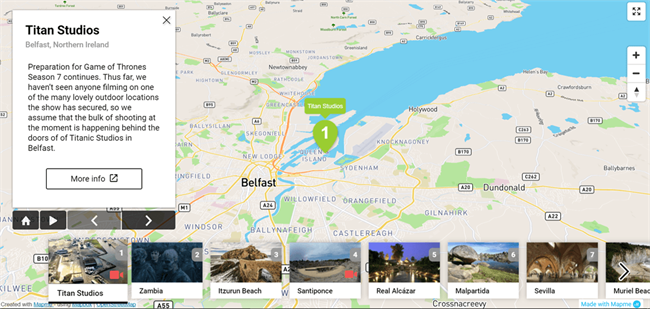Engagement Tactics in Focus

by Amberly Dressler
22 May, 2017
Engaged customers are far more valuable to enterprises in terms of profitability, revenue and relationship growth than average, unengaged visitors.
Interactive elements serve both functions: personalization and self-service. Types of interactive elements include calculators, dynamic timelines, brackets (think March Madness), guided search, quizzes, maps, real-time data and more. Read, " Ditch Your Static Pages for Interactive Content that Boosts Conversions."
HBO or a fan site, for example, could use Mapme to provide an interactive map on their website showing where the wildly popular series Game of Thrones (GOT) is filming. The map isn't just a one-time click as visitors are able to click through each location for more information about the area and insights into GOT (increasing time spent on the site). A website could take engagement a step further and offer to provide real-time alerts when filming crews move or when more information is received (to get people back to the site).

Likewise, companies across industries can generate ideas of what can be a "bracket" on their website. A parents' blog, for instance, could use Brackify to create a bracket for the best TV mom, which keeps people on the site and encourages them to return to see how their "picks" panned out. With Brackify, marketers can customize fonts, colors, regions, seeds as well as create a bracket with access to daily stats (users, votes). The corporate level of the tool provides the ability to require an email before visitors vote (good for new customer acquisition and to be able to market to returning visitors whose information has not yet been captured).

Finally, SnapApp is a drag-and-drop tool that can be used to create interactive content such as calculators, assessments, contests and sweepstakes, polls, brackets, galleries, knowledge tests and quizzes and interactive videos. The company provides an example of an interactive infographic from a home warranty business that shows end-users how to keep their homes and families safe during the winter. View the live example here.

Whether it's a free two-week trial of a software, an offer for a free download of content or a free, lightweight option of the paid version, considering how to get a "sample" of a product or service in the digital hands of website visitors is an engagement win.
CoSchedule, for instance, recently released a Social Message Optimizer that scores a person's social media posts (across networks) before they hit send. This allows the end-user to tweak the messaging based on CoSchedule's recommendations (pulled from best practices and current data). The Social Message Optimizer is a product on its own - meaning it can be used for free without signing up for CoSchedule - but complement's the company's paid offering (which also comes with a 14-day free trial). As people start to use and enjoy CoSchedule's optimization tool, they will likely be more open to exploring what the company offers with the help of the marketing messages likely to be directed their way (an acceptable trade-off for using the free tool).

For example, Macy's provides a section on its product pages for product Q&A and customer photos, which are either curated from social media pages or uploaded directly to the website by shoppers.

Discover three proven tactics to turn lurkers into fully engaged contributors of a digital community.
1. Use Interactive Elements
One way websites can capture and retain the attention of visitors is to provide them with information that is personalized to them. Couple the desire for personalized content with the need to self-serve and enterprises have a recipe for engagement they'll want to repeat.Interactive elements serve both functions: personalization and self-service. Types of interactive elements include calculators, dynamic timelines, brackets (think March Madness), guided search, quizzes, maps, real-time data and more. Read, " Ditch Your Static Pages for Interactive Content that Boosts Conversions."
HBO or a fan site, for example, could use Mapme to provide an interactive map on their website showing where the wildly popular series Game of Thrones (GOT) is filming. The map isn't just a one-time click as visitors are able to click through each location for more information about the area and insights into GOT (increasing time spent on the site). A website could take engagement a step further and offer to provide real-time alerts when filming crews move or when more information is received (to get people back to the site).

Likewise, companies across industries can generate ideas of what can be a "bracket" on their website. A parents' blog, for instance, could use Brackify to create a bracket for the best TV mom, which keeps people on the site and encourages them to return to see how their "picks" panned out. With Brackify, marketers can customize fonts, colors, regions, seeds as well as create a bracket with access to daily stats (users, votes). The corporate level of the tool provides the ability to require an email before visitors vote (good for new customer acquisition and to be able to market to returning visitors whose information has not yet been captured).

Finally, SnapApp is a drag-and-drop tool that can be used to create interactive content such as calculators, assessments, contests and sweepstakes, polls, brackets, galleries, knowledge tests and quizzes and interactive videos. The company provides an example of an interactive infographic from a home warranty business that shows end-users how to keep their homes and families safe during the winter. View the live example here.

2. Offer Free Trials/Versions
Food demos at grocery stores increase sales, as people get a free sample and they are presented with something to buy that they've just tried (often accompanied by a coupon). Marketers and Web designers can take this idea and apply it to their websites in order to engage "lurkers" in a way that helps quiet their reasons for previous resistance to sign up, buy or make themselves known somehow (e.g., fill out a form, contact).Whether it's a free two-week trial of a software, an offer for a free download of content or a free, lightweight option of the paid version, considering how to get a "sample" of a product or service in the digital hands of website visitors is an engagement win.
CoSchedule, for instance, recently released a Social Message Optimizer that scores a person's social media posts (across networks) before they hit send. This allows the end-user to tweak the messaging based on CoSchedule's recommendations (pulled from best practices and current data). The Social Message Optimizer is a product on its own - meaning it can be used for free without signing up for CoSchedule - but complement's the company's paid offering (which also comes with a 14-day free trial). As people start to use and enjoy CoSchedule's optimization tool, they will likely be more open to exploring what the company offers with the help of the marketing messages likely to be directed their way (an acceptable trade-off for using the free tool).

3. Get Real
As clever as marketers can be, people will always hold the opinions of their peers in higher regard than the companies they know are trying to sell them, which is why user reviews are so popular and sought after. People will also want to do their own research by getting real-world insights into what a business looks like, how the products appear after they've been received (compared to staged product images) and how a service has helped people/companies like them/theirs. Enterprises should evaluate all possibilities of how to add "real world" elements onto their sites, which can include:- Interactive tours of a business (like with Google Business View)
- The ability for ecommerce shoppers to upload photos of the products on receipt/use
- Videos of testimonials, product demos and tutorials
- Using "real" models in marketing collateral (whether that's real-life shoppers or employees)
- Offering forums or Q&As where "real" people can speak to one another in real-time
For example, Macy's provides a section on its product pages for product Q&A and customer photos, which are either curated from social media pages or uploaded directly to the website by shoppers.

Avoid Brochureware
Although it has meaning from decades long gone, some sites resemble brochureware with static content that does little to keep visitors engaged. By incorporating some of these engagement tactics, however, brands can start to see people spend more time on their sites and ultimately convert if they becoming engaged members of their digital community - bringing along their peers in the process.

Amberly Dressler
Head of analyst relations, public relations, customer advocacy (People Heroes), customer community, content marketing (full funnel/lifecycle), content operations and optimization, reputation management and social media. Leads a team of nine superstars to exceed our goals multi-fold.









